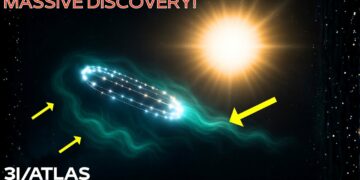Tonight, we conclude with the clearest images ever captured of Neptune, the most distant planet in our solar system. Observations of Neptune’s orbit reveal deviations from Newton’s laws, presenting a significant challenge. These unprecedented images of the icy giant have unveiled a shocking discovery, captivating scientists and dreamers alike with Neptune’s mysterious allure, long shrouded in secrecy and fascination. Through relentless scientific efforts, researchers are on the cusp of a groundbreaking breakthrough. The clearest pictures ever taken of this distant world offer a glimpse into Neptune’s stormy atmosphere, revealing a finding that will forever alter our understanding of the solar system’s outer reaches.
In August 1977, Voyager 2 embarked on an extraordinary journey through our solar system, venturing into uncharted territory. This mission marked a pivotal moment in space exploration, aiming to explore the outer reaches of our celestial neighborhood. After a 12-year voyage, Voyager 2 reached Neptune in 1989, capturing breathtaking footage that revealed a majestic world cloaked in swirling bands of azure clouds. Picture a distant sibling of Jupiter, adorned in mesmerizing shades of blue. Voyager 2 detected a colossal storm raging across Neptune’s atmosphere, resembling a massive, slate-colored tempest. The spacecraft also discovered four mysterious rings encircling the planet and six previously unknown moons, enhancing the enigma of this distant realm. Despite traveling 7.1 billion kilometers, Voyager 2’s encounter with Neptune was brief, lasting only a few hours. Yet, this fleeting rendezvous provided humanity with unparalleled views of the icy giant, capturing the essence of Neptune’s captivating beauty.
The iconic image of Neptune, immortalized by Voyager 2, showcases towering white clouds and turbulent storms, bathed in a famous but misleading blue hue. In reality, Neptune’s true color is a softer, lighter greenish-blue, a subtle detail often overlooked in the grandeur of space exploration. Online searches for Neptune images reveal a surprising scarcity, despite Voyager 2’s remarkable feat of flying within 4,950 kilometers of the planet’s surface. Neptune’s elusiveness stems from its vast distance—30 times farther from the Sun than Earth—receiving only a fraction of the sunlight we enjoy. When Voyager 2 reached Neptune after its gravity-assisted journey past other outer planets, it was traveling at an astonishing 27 kilometers per second. Capturing Neptune’s mesmerizing blue hue and mysterious atmosphere proved challenging, as the planet receives just 0.1% of Earth’s sunlight, making clear, non-blurry photos difficult to obtain.
Voyager 2’s ingenuity prevailed, using deft thruster maneuvers and extended exposure techniques to capture and transmit some of the closest and most mesmerizing images of Neptune. Just hours before its closest approach, the spacecraft snapped an incredibly detailed picture, revealing high-altitude, wispy clouds resembling Earth’s cirrus clouds. Unlike Earth’s water vapor clouds, these are made of frozen methane, giving them a surreal appearance. Stretching thousands of kilometers parallel to Neptune’s equator, these clouds span 50 to 200 kilometers wide and cast shadows onto a hazy layer 50 kilometers below. Remarkably, Voyager 2’s images of Neptune provided the first glimpse of these elusive cloud shadows, a feature unseen on other gas giants. Recent Hubble Space Telescope observations show these clouds form and vanish rapidly, highlighting the dynamic nature of Neptune’s weather.
When Voyager 2 captured these images, strong winds swirled around the icy giant, some reaching speeds of 2,100 kilometers per hour—three times faster than Jupiter’s winds and nearly nine times faster than Earth’s. Neptune hosts some of the solar system’s most extreme weather, exemplified by the Great Dark Spot, a massive, oval-shaped cyclone the size of Earth, resembling Jupiter’s Great Red Spot. This storm’s center appeared as a vast, dark void slicing through Neptune’s atmosphere. Neptune, an ice giant four times wider than Earth with a radius of approximately 15,300 miles, boasts a volume 58 times larger than our planet. Composed primarily of water, methane, and ammonia, Neptune lacks a solid surface. Its thick atmosphere extends to a mantle of methane and ammonia ice surrounding a rocky core. Scientists speculate that a superheated ocean may exist deep within, despite Neptune’s icy exterior and frigid atmospheric temperatures averaging -360°F, making it one of the solar system’s coldest places.
Though Neptune cooled between 2003 and 2018, warming near the South Pole from 2018 to 2020 suggests seasonal atmospheric changes. The mystery of a potential ocean remains unsolved, with theories pointing to internal heating from gravitational compression or interactions with Neptune’s largest moon, Triton. However, researchers like Sloan Viktorovich and Andrew Ingel estimate only a 15% chance of such an ocean forming, potentially requiring a billion years to reach a 40% likelihood as Neptune cools. Neptune’s immense internal energy, radiating nearly three times more than it absorbs from the Sun, may stem from a past collision with a cosmic object. Its 28° axial tilt, similar to Earth’s, creates seasons lasting 40 years each, with a year equaling 165 Earth years and a day lasting 16 hours. This rapid rotation drives Neptune’s extreme winds.
Neptune’s atmosphere, composed of 80% hydrogen, 19% helium, and 1% other gases including methane, owes its striking blue color to methane clouds that absorb red light and reflect blue. High-altitude methane ice clouds enhance this coloration, scattering sunlight similarly to Earth’s blue skies. Neptune’s dynamic atmosphere features massive storms and powerful winds, contrasting with Uranus’s muted pale blue hue, influenced by its unique tilt and prolonged polar winters. Both planets’ atmospheres contain trace amounts of hydrogen, helium, and ammonia, creating complex environments for scientific exploration.
Neptune’s storms, spanning thousands of kilometers, are driven by its rapid rotation, making it the windiest planet in the solar system. The Great Dark Spot, discovered by Voyager 2, vanished by the time Hubble observed it, revealing the transient nature of Neptune’s weather. In 2018, Hubble captured a new storm, which unexpectedly reversed its southward drift to move northward, defying expectations. A smaller vortex breaking away from the main storm may contribute to its fragmentation, a phenomenon unseen before. Bright methane “scooter clouds” within these storms, propelled by unknown forces, add complexity to Neptune’s atmosphere.
In 2022, the James Webb Space Telescope captured stunning images of Neptune’s rings, unseen in such detail since Voyager 2’s visit. Five distinct rings, named after astronomers, orbit Neptune: Galle, a diffuse, dusty ring spanning 1,240 miles; Le Verrier, 62 miles wide; Lassell, 2,485 miles wide with 20-40% dust; Arago, barely visible; and Adams, the narrowest at 35 kilometers. The Adams ring features mysterious arcs—bright dust bands named Freedom, Brotherhood, Courage, and Equality—that dynamically exchange material, their formation possibly linked to the collapse of a celestial object within Neptune’s Roche limit.
Webb also imaged seven of Neptune’s 14 moons, including six inner, regular moons. Despina and Galatea act as shepherds, using gravitational forces to maintain the rings’ sharp edges. Triton, Neptune’s largest moon, orbits retrograde, likely a captured Kuiper Belt object. Its nitrogen ice surface reflects 70% of sunlight, making it shine brightly. Triton’s diameter of 1,680 miles accounts for 99.7% of Neptune’s moon mass, and its surface, at -391°F, is geologically active with nitrogen geysers. Voyager 2 revealed Triton’s frozen plains, cliffs, and dark streaks, with fresh craters suggesting recent impacts and eroded ones hinting at cryovolcanism. Scientists suspect a subsurface ocean, possibly sustained by tidal heating from Neptune’s gravitational pull and Triton’s eccentric orbit, making Triton a prime target for future exploration.
Triton’s nitrogen atmosphere, formed by solar heating, and its plumes of icy material suggest a subsurface reservoir of volatile compounds, with ammonia acting as antifreeze. Triton’s retrograde orbit, unique in the solar system, indicates its Kuiper Belt origin, captured by Neptune’s gravity. The Kuiper Belt, rich in methane, ammonia, and water ice, holds clues to the solar system’s early formation. Neptune’s migration during the solar system’s infancy, driven by gravitational interactions, shaped the Kuiper Belt and influenced other planets’ orbits.
Neptune’s mysteries—its internal composition, ice giant formation, and dynamic atmosphere—continue to captivate scientists. Future missions promise to unravel its chemistry and role in the universe, deepening our understanding of planetary systems. Each discovery brings humanity closer to unraveling the cosmic mysteries that have fascinated us for generations.























